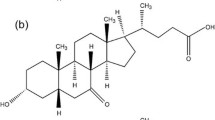Abstract
Human liver had been shown to contain two forms of lithocholic acid. One form is extractable by 95% ethanol-ammonia, 1000∶1, v/v (soluble lithocholate, SL) and the other form is firmly bound to the tissue residue. The latter, tissue-bound lithocholic acid (TBL), can be enzymatically released by means of the specific clostridial peptide bond hydrolase, cholylglycine hydrolase (cholanoyl amino acid hydrolase, EC no. 3.5). Solvolytic procedures for the analysis of hepatic lithocholic acid sulfate revealed that almost all of the TBL was non sulfated, while in the SL fraction there was an apparent preponderance of the sulfated form. Cholylglycine hydrolase liberates free labeled lithocholic acid from synthetic [24-14C] lithocholyl-bovine serum albumin and from [24-14C]lithocholyl polylysine. By analogy, the enzyme releases lithocholic acid from tissue protein in which the bile acid is conjugated through amino groups of basic side chains. Hydrolysis of [24-14C] lithocholyl polylysine with 6n HC1 yielded ∈-[24-14C] lithocholyl lysine, which was chromatographically similar to the product obtained by acid hydrolysis of TBL. Chromatographic, infrared, and mass spectroscopic studies with synthetic N-α-lithocholyl lysine, N-∈-lithocholyl lysine, and N-α-∈-Bis lithocholyl lysine showed the hydrolytic product from TBL to be N-∈-lithocholyl lysine. Since monohydroxy bile acids, such as lithocholic acid, are known to show unusual cytotoxic properties, the identification of TBL in human liver poses important questions regarding the role of lithocholate in liver injury.
Similar content being viewed by others
References
Danielsson, H., in “The Bile Acids,” Vol. 2, Edited by P.P. Nair and D. Kritchevsky, Plenum Press, New York, NY, 1973, pp. 1–32.
Bengmark, S.P., P.H. Ekdahl, and R. Olsson, Gastroenterolgia 99:327 (1963).
Peric-Golia, L., and R.S. Jones, Proc. Soc. Exp. Biol. Med. 110:327 (1962).
Peric-Golia, L., and R.S. Jones, Science 142:245 (1963).
Gordon, B.A., A. Kuksis, and J.M.R. Beveridge, Can. J. Biochem. Physiol. 41:77 (1963).
Yousef, I.M., and M.M. Fisher, Can. J. Physiol. Pharm. 53:880 (1975).
Sherr, H.P., P.P. Nair, J.J. White, J.G. Banwell, and D.H. Lockwood, Am. J. Clin. Nutr. 27:1369 (1974).
Okishio, T., P.P. Nair, and M. Gordon, Biochem. J. 102:654 (1967).
Nair, P.P., M. Gordon, and J. Reback, J. Biol. Chem. 242:7 (1957).
Nair, P.P., in “Bile Salt Metabolism,” Edited by L. Schiff, J.B. Carey, and J.M. Dietschy, Charles C. Thomas, Springfield, IL 1969, p. 172.
Nair, P.P., and C. Garcia-Lilis, Anal. Biochem. 29:164 (1969).
Elliott, W.H., in “The Bile Acids”, Vol. 1, Edited by P.P. Nair and D. Kritchevsky, Plenum Press, New York, NY, 1971, p. 47.
Okishio, T., and P.P. Nair, Anal. Biochem. 15:360 (1966).
Makino, I., and J. Sjovall, Anal. Lett. 5:341 (1972).
Bezas, B., and L. Zervas, J. Am. Chem. Soc. 83:719 (1961).
Vaughan, J.R., and R.L. Osato, Ibid. 74:676 (1952).
Myher, J.J., L. Marai, A. Kuksis, I.M. Yousef, and M.M. Fisher, Can. J. Biochem. 53:583 (1975).
Agarwal, K.L., and M.M. Dhar, Steroids 6:106 (1965).
Isumiya, N., and S. Nakasumi, J. Chem. Soc. (Japan) 78:662 (1957).
Palmer, R.H., and M.G. Bolt, J. Lipid Res. 12:671 (1971).
Moore, G.J., and N.L. Benoiton, Can. J. Biochem. 53:1145 (1975).
Panveliwala, D.K., D. Persemlidis, and E.H. Ahrens, Jr., J. Lipids Res. 15:530 (1974).
Goswami, S.K., and C.F. Frey, J. Chromatogr. 53:389 (1970).
Palmer, R.H., P.B. Glickman, and A. Kappas, J. Clin. Invest. 41:1573 (1962).
Palmer, R.H., Arch. Intern. Med. 130:606 (1972).
Rudman, D., and F.E. Kendall, J. Clin. Invest. 36:538 (1957).
Author information
Authors and Affiliations
About this article
Cite this article
Nair, P.P., Mendeloff, A.I., Vocci, M. et al. Lithocholic acid in human liver: Identification of ∈-lithocholyl lysine in tissue protein. Lipids 12, 922–929 (1977). https://doi.org/10.1007/BF02533312
Received:
Issue Date:
DOI: https://doi.org/10.1007/BF02533312




